Exploring the Journey of Lewis and Clark: An Educational Adventure


Nature Topic Overview
The expedition of Lewis and Clark is a significant part of American history. Their journey from 1804 to 1806 opened up the uncharted territories of the western United States. It was not just a simple trip; it was a quest filled with adventure, discovery, and learning. Lewis and Clark aimed to explore the unknown, meet new people, and document various species of plants and animals along the way. This article will examine their motivations, the challenges they faced, and the vital interactions with different cultures.
The expedition helped map a vast area that was previously unexplored. This journey involved close observations of the environment and careful notes about the lifestyle and traditions of Native American tribes they encountered. The experiences of Lewis and Clark still resonate today, offering lessons about exploration, teamwork, and respect for nature.
Fun Facts and Trivia
- Lewis and Clark traveled over 8,000 miles during their journey.
- They met more than 50 different Native American tribes along the route.
- The expedition had a dog named Seaman, who was a loyal companion.
- Lewis and Clark’s journey helped set the stage for the westward expansion of the United States.
Visuals like maps or drawings can enhance young readers' understanding. Interactive elements, such as quizzes about the various tribes they met, can help reinforce these facts.
Wildlife Explorations
During their journey, Lewis and Clark encountered numerous species important to their mission. Some notable examples include:
- American Bison: These large animals roamed the plains and were crucial for food.
- Pronghorn Antelope: Known for their speed, these animals were abundant in the West.
- Various Birds: Including the Western Meadowlark, they recorded many bird species.
It can be fun to include quizzes about their findings. For instance, ask students to identify different animals using pictures or descriptions from their notes.
Environmental Awareness
Understanding the importance of conservation is a central theme of the journey. Lewis and Clark's notes on nature highlight the need to protect these vast landscapes. Children can learn that taking care of the earth is their responsibility. Here are some tips:
- Reduce waste by recycling paper and plastic.
- Participate in clean-up outings in local parks.
- Plant trees or create a small garden to help local wildlife.
Fostering love for nature encourages children to act responsibly.
DIY Nature Activities
Engaging with nature can take many forms. Here are some hands-on activities to inspire children:
- Nature Journal: Encourage kids to keep a journal documenting their own explorations outside. They can draw or write about plants and animals.
- Crafts from Nature: Create art using leaves, twigs, and other natural materials.
- Outdoor Treasure Hunt: Organize a scavenger hunt to find different natural objects.
Each activity provides an opportunity for kids to explore and discover their environment, applying what they learn from the expedition.
Prelude to Lewis and Clark's Expedition
The journey of Lewis and Clark marks a pivotal chapter in American history. Their expedition into uncharted territories expanded the knowledge about the West and its diverse landscapes. This section serves to introduce the expedition's significance, underscoring how these explorers laid groundwork for future explorations and settlements. Not only did their journey chart new routes, but it also initiated crucial interactions with various Native American tribes. Understanding this background provides valuable insights into the complexities and challenges of exploration during the early 19th century.
Background of the Expedition
The Lewis and Clark expedition, officially known as the Corps of Discovery, was commissioned by President Thomas Jefferson in 1803. Following the Louisiana Purchase, there was a desire to map this vast new territory. The expedition aimed to find a water route to the Pacific Ocean while documenting the land, plants, animals, and the different peoples they would encounter. Meriwether Lewis and William Clark were chosen to lead this ambitious mission.
The team left St. Louis in May 1804 and consisted of around 40 men. They faced numerous challenges, including harsh weather, treacherous landscapes, and the unknown cultures of Native Americans. These difficulties shaped their resolve and defined their experiences throughout the journey.
Goals of the Journey
The primary goals of Lewis and Clark's expedition included:
- Exploration of the Louisiana Territory: Mapping the newly acquired land was essential for future American expansion.
- Finding a Northwest Passage: This was a hoped-for navigable water route connecting the Atlantic and Pacific Oceans.
- Scientific Observation: They documented flora and fauna, enhancing understanding of the natural resources in the region.
- Establishing Relations with Native Tribes: By meeting different tribes, they aimed to forge alliances and gather information on the land and resources.
Their goals reflect not only a thirst for knowledge but also a strategic approach to engaging with the environment and its inhabitants. The expedition’s perseverance through adversity ultimately left a lasting legacy, inspiring future explorers and shaping the United States' westward expansion.


"Exploration is curiosity, and curiosity leads to discovery."
The importance of understanding the expedition goes beyond its historical milestones. It teaches us valuable lessons about collaboration, resourcefulness, and the spirit of adventure. The journey of Lewis and Clark offers an inspiring framework for young learners, highlighting the significance of exploration in the pursuit of knowledge.
The Key Figures: Meriwether Lewis and William Clark
The figures of Meriwether Lewis and William Clark stand at the forefront of the historic expedition that reshaped our understanding of the American West. Their contributions were not just pivotal in the success of the journey, but also essential in the documentation and mapping of new territories. Lewis and Clark's partnership combined unique skill sets, thus making them effective leaders and navigators. This duality in their roles facilitated a well-coordinated effort that remained focused on their mission.
Meriwether Lewis: The Leader
Meriwether Lewis was chosen by President Thomas Jefferson to lead the expedition. His familiarity with nature and strong leadership skills made him an ideal leader. Lewis had received military training and had a keen interest in science, specifically in botany and geology. These qualifications allowed him to take charge in various situations throughout the journey.
Lewis was responsible for several important tasks. He kept detailed journals of the expedition. He documented not just the geography but also the flora and fauna encountered along the way. His notes helped scientists and explorers understand the land better later on. Moreover, his leadership style was characterized by a combination of decisiveness and empathy, which proved crucial during stressful moments. His sentience in recognizing group dynamics helped maintain morale among the crew.
William Clark: The Navigator
William Clark complemented Lewis's leadership with his exceptional navigation skills. Once chosen as Lewis's co-leader, Clark showcased his expertise in cartography. He had spent years studying maps, which became invaluable during their travels. Clark’s keen sense of direction and ability to survey terrain added a layer of efficiency to their mission.
Clark's role extended beyond navigation. He also managed the logistics of the expedition, including supplies and the daily operations of the team. His meticulous planning ensured that the team was prepared for various challenges. Understanding the territory was vital. Therefore, his navigational skills not only steered them through uncharted lands but also created a lasting legacy of American mapping.
The Team: Sacagawea and Others
The success of Lewis and Clark's expedition can also be attributed to the team members that accompanied them, notably Sacagawea. A Shoshone woman, she proved indispensable during the journey. Sacagawea’s knowledge of the land and her ability to communicate with various Native American tribes facilitated crucial interactions. She helped bridge cultural gaps and established important alliances.
The expedition also included other dedicated members. Each played specific roles that were vital for their success:
- York: Clark’s enslaved servant, who contributed physically and socially to the group.
- John Ordway: A sergeant who kept records and managed supplies.
- Patrick Gass: A carpenter who repaired equipment and structures.
Their diverse skills and backgrounds enriched the expedition's experience. Through teamwork, they not only accomplished their goals but also laid the foundation for future explorations.
"The value of teamwork and shared knowledge cannot be overstated in the context of the Lewis and Clark expedition."
The combined efforts of Lewis, Clark, and their diverse team illustrate how individual strengths can lead to collective success. Their journey is a testament to how effective leadership and collaboration can overcome obstacles in the face of the unknown.
The Route: Mapping New Territory
The expedition led by Lewis and Clark was as much about mapping new territories as it was about discovery. Understanding the route they took provides insight into the challenges they overcame and the landmarks they encountered along the way. This journey filled in the gaps in the maps of early America, guiding future explorers and settlers.
Starting Point: St. Louis
St. Louis, located at the confluence of the Missouri and Mississippi Rivers, was the official starting point for Lewis and Clark's expedition. It was a bustling city that served as a gateway to the west. The city was a hub for trade and the place where supplies were gathered. Here, Lewis and Clark organized their supplies and recruited a crew. By choosing St. Louis, they positioned themselves strategically for the journey ahead.
Here are some critical aspects of St. Louis:
- Population Center: It was an important settlement in this period.
- Trade Opportunities: The city was alive with traders, giving the expedition access to necessary resources.
- Preparation Base: It allowed the team to gather knowledge and materials before heading into unknown territory.
This starting point was not just a geographical landmark. It symbolized the beginning of an adventurous challenge, setting the tone for what was to come.
Traversing the Missouri River
Once the expedition set off, the Missouri River became the primary route for their journey. The river served as a natural pathway, offering the team a means to navigate through challenging landscapes. Many obstacles emerged like fast currents and rough waters, but the river also provided everything they needed to survive. Fish, clean water, and lush vegetation were in abundance along its banks.
Key elements of traversing the Missouri River include:
- Navigational Aid: The river guided their way through uncharted territory.
- Resource Supply: It served as a constant source of food and fresh water.
- Obstacles Encountered: They faced difficult weather patterns and shifting river channels that tested their skills.


Throughout this leg of the journey, they learned to adapt and innovate, building their resilience. Observational skills sharpened as they made note of various flora and fauna along the river banks.
Reaching the Pacific Ocean
The final destination of the expedition was the Pacific Ocean. As Lewis and Clark traveled west, they ventured through diverse terrains. They encountered mountains, forests, and plains. Each region brought new surprises and challenges.
Reaching the ocean had significant implications:
- Geographical Understanding: It completed the mapping, revealing the vastness of the American land.
- Symbol of Achievement: The Pacific Ocean represented the triumph of their expedition.
- Interactions: They met various Native American tribes, gathering valuable insights and fostering relationships.
In closing, the expedition underscored the importance of determination and exploration. The route not only shaped the journey of Lewis and Clark but also laid the groundwork for future expeditions into the American West.
"Lewis and Clark's journey was not just about discovery, it was about understanding the vast landscapes and the people who lived within them."
Their voyage through St. Louis, along the Missouri River, and finally to the Pacific Ocean served as essential chapters in the story of America, fostering a deeper understanding of geography and culture.
Nature Encounters: The Flora and Fauna
The exploration of Lewis and Clark was not just a journey through uncharted land; it was also a significant opportunity to observe and document the many plants and animals inhabiting the vast terrain of early America. Understanding these encounters is crucial for several reasons. First, they highlighted the biodiversity that existed in the region, providing insight into ecosystems that thrived long before major industrial development. Second, the observations contributed to the scientific knowledge of the time, influencing future explorations and studies in natural history. Lastly, these encounters underscored the intertwined relationship between the explorers and the environment, serving as an example of early environmental observation and awareness.
New Species Discovered
During their expedition, Meriwether Lewis and William Clark recorded numerous new species of plants and animals. Some of these had never been seen by Europeans before. For instance, Lewis's woodpecker and the prairie dog were among the notable species that they identified and documented. The explorers also collected specimens and made careful notes about habitats and behaviors. This wasn't just a casual observation; it was critical for understanding the rich tapestry of life present in North America.
- Lewis's Woodpecker: This bird is known for its vivid colors and distinctive behavior.
- Prairie Dog: A small mammal that lives in underground colonies, fundamental for the ecosystem.
These discoveries were important as they provided a foundational understanding of North American wildlife at the time. They paved the way for future naturalists and scientists to expand on the knowledge collected by Lewis and Clark.
Impact of the Expedition on Natural History
The contributions of Lewis and Clark to natural history were profound. They created a detailed record which would benefit scientists for generations. The newfound knowledge facilitated advances in various fields such as botany and zoology. Moreover, their maps and notes helped subsequent explorers and settlers comprehend the resources available in these territories.
Improvements in scientific methods also began to take shape due to these discoveries. Their journey emphasized accuracy and documentation through observation, laying groundwork for later exploration and study.
"The expedition’s findings set the stage for America’s expanding interest in natural history. It connected the dots between geography, flora, and fauna, revealing the rich biotic community of the Americas to a wider audience.”
Interactions with Native American Tribes
Engaging with Native American tribes significantly shaped the Lewis and Clark expedition. The tribes were not just obstacles to overcome but essential allies who provided wisdom and assistance. Interactions with these groups offered the explorers insights into the land, culture, and resources available. These encounters helped Lewis and Clark navigate the unknown territories more safely and efficiently. It is vital for young learners to understand how collaboration and respect were crucial to their journey.
Significant Encounters
During their expedition, Lewis and Clark met several Native American tribes whose knowledge of the land was invaluable. A few key encounters include:
- The Osage Nation: The Osage were among the first tribes Lewis and Clark interacted with. Their guidance helped the explorers find their way through the dense forests and unfamiliar terrains. They exchanged goods, which strengthened relations.
- The Mandan Tribe: The Mandan people played a major role in the expedition. Lewis and Clark spent the winter of 1804-1805 with them. This provided time to rest and prepare for the next leg of their journey. The Mandan offered food and shelter during harsh weather and shared crucial information about the lands ahead.
- Sacagawea's Tribe: Sacagawea, a Shoshone woman who joined the expedition, had a significant impact. Her knowledge of the region was crucial for navigating. Her connections with her tribe assisted in obtaining horses necessary for crossing the Rocky Mountains.
These encounters not only provided practical help but also fostered understanding between cultures. Each meeting carried the potential for learning and cooperation.
Cultural Exchanges
Interactions between Lewis and Clark and Native American tribes were full of cultural exchanges. These exchanges involved sharing knowledge, traditions, and resources, enriching both parties. Some aspects of these cultural exchanges include:
- Shared Knowledge: The explorers learned survival skills essential for their journey. The Native tribes taught them about local plants, animals, and sustainable practices in the wilderness. This knowledge was vital in dealing with food shortages and navigating harsh climates.
- Artistic Exchange: The two cultures shared artistic expressions, from storytelling to crafts. Native Americans had intricately designed clothing, tools, and art that inspired the explorers. Conversely, the explorers shared their own stories and tools, fostering mutual appreciation.
- Language Learning: Communication between the two groups required some effort. Lewis and Clark learned basic phrases of Native languages to facilitate better communication. This helped build trust and respect during interactions.
In summary, the interactions with Native American tribes were not just incidental contacts; they were foundational to the success of the expedition. These experiences highlighted the importance of understanding and respecting different cultures, a lesson valuable for young minds today.


Challenges Faced During the Expedition
The journey of Lewis and Clark was not just about exploration, but also about overcoming various challenges. This part of the article highlights the significant obstacles faced by the expedition. Understanding these challenges is crucial as they shaped the outcomes of the journey. The hardships the team encountered illustrate the resilience required for exploration and offer valuable lessons in perseverance and problem-solving.
Harsh Weather Conditions
Weather played a key role in the expedition. From extreme cold to heavy rains, the conditions were often brutal. For instance, during the winter months, the team faced sub-zero temperatures, making survival a daily struggle. Their tents provided little protection against the elements. This constant battle with nature tested the limits of their endurance.
The effects of weather were not only physical. Harsh conditions led to a range of issues, including illness among the team members. Frostbite and hypothermia were serious threats, making it urgent to find shelter and warmth. The team learned to rely on each other, forge connections, and adapt their plans based on the weather. By changing their route or deciding when to camp, they navigated through some difficult situations.
Supply Shortages
Alongside adverse weather, supply shortages were always a concern. As the journey progressed, the team found it hard to find enough food. Initially, they planned well and started with ample supplies. However, as they moved deeper into uncharted territories, their resources dwindled. They often had to rely on hunting and gathering to sustain themselves, which did not always yield enough.
Running low on supplies forced the team to be creative. For example, they started to hunt new animals and look for edible plants. They also learned from Native American tribes about local resources. This not only helped them survive but also demonstrated the importance of adaptability and resourcefulness.
In summary, the challenges faced by Lewis and Clark were numerous. Harsh weather conditions and supply shortages tested their resolve, yet they emerged as pioneers. Their experiences serve as a powerful reminder of the trials that come with exploration. This part of their journey emphasizes the significance of determination and teamwork in the face of adversity.
"The greatest glory in living lies not in never falling, but in rising every time we fall." - Nelson Mandela
The Legacy of Lewis and Clark
The legacy of Lewis and Clark is a multifaceted topic that embodies not only their significant contributions to American history but also the larger story of exploration, cooperation, and the understanding of new lands. Their expedition changed the course of American geography and left an indelible mark on the nation's cultural landscape.
Impact on American History
The expedition led by Meriwether Lewis and William Clark in the early 1800s was pivotal in shaping the United States. It provided invaluable information about the land acquired through the Louisiana Purchase. This territory was vast and largely unknown. The detailed maps created during their journey helped future travelers and settlers navigate these lands. They documented over 120 new species of plants and animals, expanding scientific knowledge at that time.
Furthermore, this expedition confirmed the United States' expansionist aspirations. It connected the eastern states to the western frontier, showing the potential for migration and settlement. Thus, Lewis and Clark served as symbols of exploration and adventure, embodying the spirit of the American frontier. Their findings prompted other explorers to follow in their footsteps, leading to further exploration and eventual settlement of the West. This had profound effects on the nation’s development, both economically and culturally.
Modern-Day Recognition
Today, the significance of Lewis and Clark is honored in various ways. There are numerous national historic trails, parks, and monuments established to commemorate their incredible journey. Lewis and Clark National Historical Park, for instance, provides educational resources about their expedition, allowing visitors to learn about the rich history of this adventure.
Many schools include their story in history curriculums. Museums across the country have displays highlighting the expedition's contributions. This modern recognition emphasizes the lasting importance of their journey in understanding America’s roots.
Today’s respect for Lewis and Clark helps us appreciate exploration and understanding of the diverse cultures that existed prior to and during their journey.
Ending: Reflecting on an Epic Journey
The expedition of Lewis and Clark is an important part of American history. It teaches about adventure, discovery, and the connections made with nature. This section of the article highlights how their journey impacted the understanding of America's vast landscape and the cultures present at that time.
Lessons from the Expedition
The lessons from Lewis and Clark's journey are many and rich. First, they show the value of preparation and planning. The team had to gather supplies, create maps, and understand the land before setting out. This teaches children the importance of being ready and thorough in any task they undertake.
Another lesson is about teamwork. Lewis and Clark could not have succeeded without their team, including Sacagawea. Each member had different skills and knowledge that contributed to the success of the expedition. It emphasizes the idea that collaboration can lead to better outcomes. By learning from others, one can achieve more than working alone.
The journey also emphasizes resilience. The expedition faced many challenges including harsh weather and dangers from wild animals. By pushing through these difficulties, they achieved their goals. This teaches young audiences that obstacles can be overcome with determination and hard work.
Encouraging Future Exploration
Encouraging exploration in today’s world can take many forms. The story of Lewis and Clark ignites curiosity about nature and history. Parents and educators can inspire children to explore their surroundings. Simple activities such as hikes, nature walks, or visits to museums can spark interest in learning about the environment and diverse cultures.
Furthermore, encouraging questions is vital. Children should feel free to ask about their world. This curiosity will lead them to discover new things and broaden their understanding.
Encouraging participation in local history projects or community service can also connect them to their heritage. These experiences promote a sense of belonging and contribution.
"Every journey begins with a single step. Let your curiosity lead the way."
In summary, the journey of Lewis and Clark provides essential lessons about preparation, teamwork, resilience, and the spirit of exploration. By reflecting on their epic voyage, we can cultivate a sense of adventure among the younger generation, encouraging them to discover and learn more about the world.







